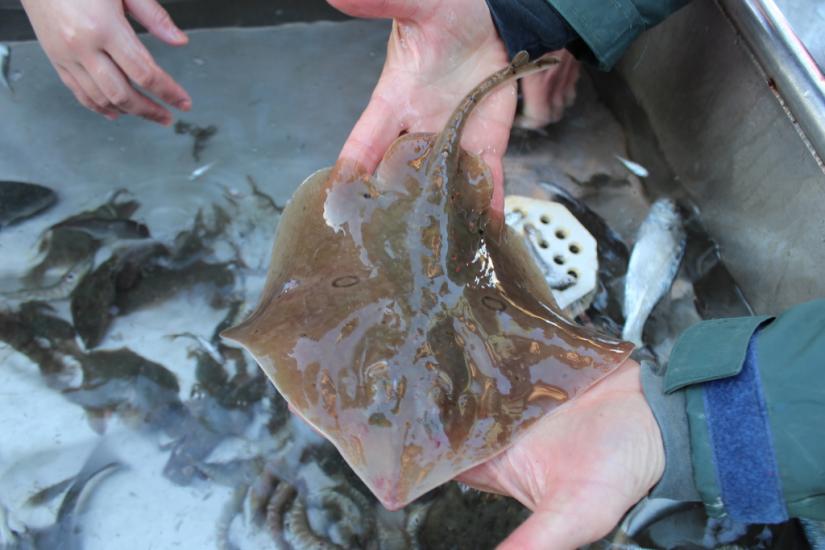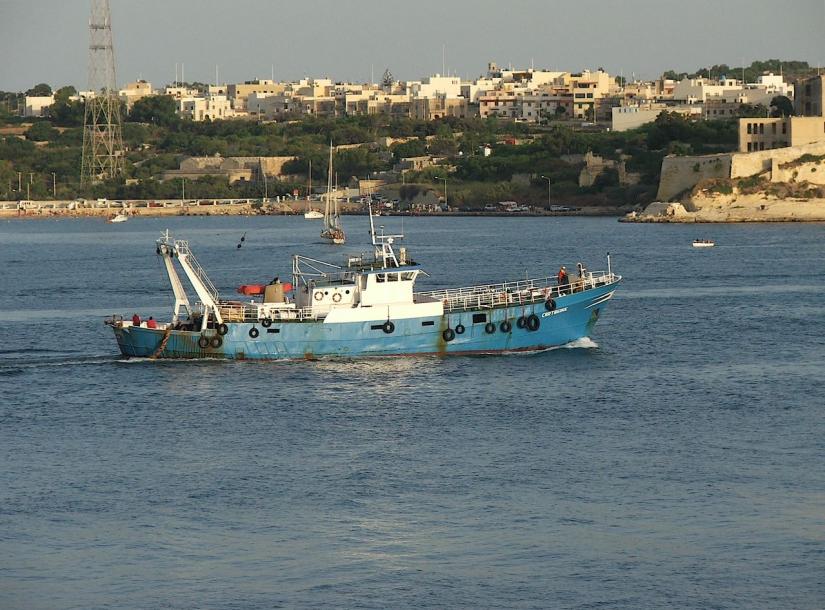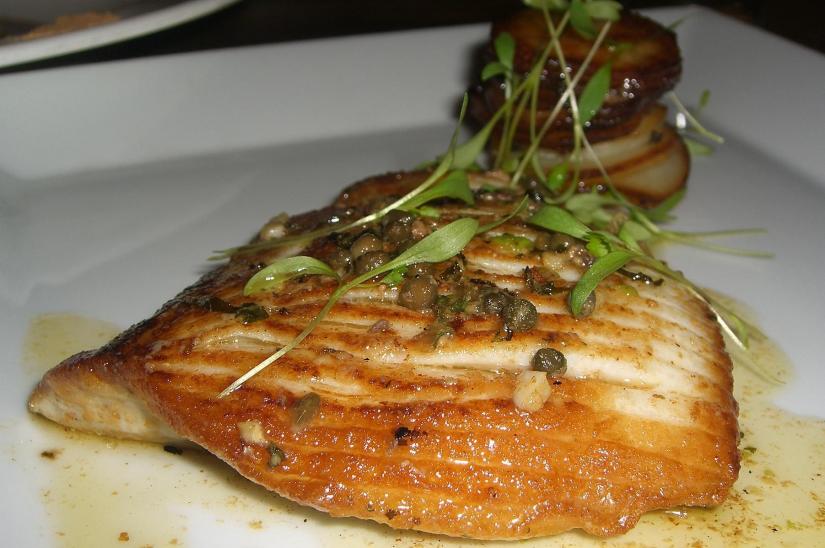California Skate
Beringraja inornata
The Science
THE SCIENCE
Unlike many rays, a skate’s tail does not have a venomous spine.

Taxonomic description
- Has a pointed snout, a tail with a mid-dorsal spine, and a flat, rhomboidal body. [1]
- Has olive-brown blotchy coloration on its dorsal side, and is mostly white on the underside. [2]
- Mature males are about 47 cm total length, and females about 52 cm total length. [16]
Distribution
- Found along the western coast of North America from central Baja, California up to the Straights of Juan de Fuca, Canada. [1]
Life history
- The female skate is estimated to live 8 years, male is estimated to live 7 years. [8]
- After internal fertilization, the female lays cases of oblong, horned eggs. [4]
- Reproduction peaks between September and November. [16]
- Young skates have tendencies to follow large figures like their mothers. [11]
Habitat
- Found along the soft bottom of inshore areas and bays. [7,11]
- Lives between depths of 17-1,600 meters, but most commonly 58-231 meters. [7,11,16]
- Found in waters between 8.2-9.6 degrees Celsius. [16]
- Preys on shrimp, crabs, and fishes. [4]
The Fishery
THE FISHERY
Skate is taken as a targeted species, but is also a common product of bycatch

Seasonal availability
- Available year round, with highest availability in summer and fall. [3,6]
Regulatory and managing authority
- Managed federally by the NOAA fisheries and, as established by the Magnuson-Stevens Act, the Pacific Fishery Management Council (PFMC) through the Pacific Coast Groundfish Fishery Management Plan (FMP). It is considered an Ecosystem Component Species under the Pacific Coast Groundfish FMP. [12,14]
- As established by the Marine Life Management Act, the California Fish and Game Commission (CFGC) regulates the fishery in state waters, and the California Department of Fish and Wildlife (CDFW) manages this fishery. [13]
Gear type
- Caught mostly by bottom trawl, but is also caught with longline, troll, pots, gillnets, and hook and line. [14]
Status of the fishery
- Considered to be of least concern because it is able to maintain population stability despite fishing pressures and regulations are in place that monitor and reduce fishing stresses. [16]
- The population is considered stable but with insufficient information, and is regarded as a “data-limited stock”. [16]
- With the enforcement of the Marine Protection Act in California, trawling has been restricted, decreasing the catch of this skate. [16]
Potential ecosystem impacts
- Bottom trawling is responsible for the most harmful impacts on marine ecosystems. [19]
- Trawling impacts formations and damages structure supporting organisms. [19]
The Seafood
THE SEAFOOD
Due to its mollusk and shellfish diet, its taste is similar to that of a shellfish- sweet and mild.


Edible portions
- The meat is located on the top and bottom of the cartilage plate through the middle of the wings. [3]
Description of meat
- Firm with a mild taste, but can have a stringy texture because of the wing structure. [3,5]
- When cooked, the slight pink color turns off white. [3,5]
Culinary uses
- Sold as skin-on wings, skin-off wings, and fillets, but the skin is too tough to be edible. [6]
- Typically baked, deep fried, poached, or sautéed. [6]
- Enjoyed with capers, mushrooms, spinach and potatoes, tomatoes and beans, and in pastas. [9,10]
- For a recipe for baked skate wing with mushroom, shallot, and Gruyère cheese, visit Great British Chefs. [20]
Nutritional information
- Nutritional information given for 100 grams (3.5 ounces) of ungarnished, unsauced skate. [5,15]
Toxicity report
- Fresh skate should not have an ammonia odor, discard if it has. [3]
Seasonal availability
- Skate is available year round and is most available in the summer and fall, but winter-caught skate is considered the best. [3,6]
References
[1] California Skate. n.d. Washington Department of Fish and Wildlife. Web. https://wdfw.wa.gov/species-habitats/species/beringraja-inornata. Accessed 27 August 2020.
[2] Snow, J. 2018. Mexico- Fish, Marine Life, Birds, and Terrestrial Life. Web. https://www.mexican-fish.com/california-skate/. Accessed 8 October 2018
[3] Seafoods.com. 2018. Skate. Web. https://www.seafoods.com/product/285-skate. Accessed 11 October 2018
[4] Cabrillo Marine Aquarium. California Skate. Web. https://www.cabrillomarineaquarium.org/exhibits/socal-species-details.a…. Accessed 12 October 2018.
[5] SeafoodSource. 2014. Skate. Web. https://www.seafoodsource.com/seafood-handbook/finfish/skate#nutritionF…. Accessed 12 October 2018.
[6] Chef’s Resources. Skate Fish. Web. https://www.chefs-resources.com/seafood/finfish/skate-fish/. Accessed 12 October 2018.
[7] Smithsonian Tropical Research Institute. 2015. Species: Raja inornata, California skate. Web.https://biogeodb.stri.si.edu/sftep/en/thefishes/species/214. Accessed 22 October 2018
[8] Ebert, D. and G. Cailliet. 2007. Life History Studies of California Chondrichthyans: Determining Essential Biological Information for Effective Management of Bycatch and Emerging Fisheries. Page 8. Web. https://escholarship.org/uc/item/3142f5nz. Accessed 27 August 2020.
[9] Louie, Elaine. 1998. Mild in Taste, Elegant in Look, Skate Joins the A-list. Web. https://www.nytimes.com/1998/08/26/dining/mild-in-taste-elegant-in-look…. Accessed 22 October 2018
[10] Food and Wine Editors. 2016. How to Cook Skate Wing. Web. https://www.foodandwine.com/blogs/how-cook-skate-wing. Accessed 22 October 2018
[11] Froesse, Rainer. Raja inornata. Web.https://www.fishbase.de/summary/Raja-inornata.html. Accessed 22 October 2018
[12] Pacific Coast Groundfish Fishery Management Plan. 2019. Pacific Fishery Management Council. Web. https://www.pcouncil.org/documents/2016/08/pacific-coast-groundfish-fis…. Accessed 21 August 2020.
[13] California Department of Fish and Wildlife. 2018. Groundfish. Web. https://www.wildlife.ca.gov/conservation/marine/groundfish#28720322-ove…. Accessed 1 November 2018
[14] NOAA Fisheries. n.d. About Groundfish Fisheries. Web. https://www.westcoast.fisheries.noaa.gov/fisheries/groundfish/. Accessed 1 November 2018
[15] Cook’s Info. Skate. Web. https://www.cooksinfo.com/skate. Accessed 1 November 2018
[16] Nehmens, M.C., Robinson, H.J., Ebert, D.A. & Cailliet, G.M. 2016. Raja inornata. The IUCN Red List of Threatened Species 2016. https://dx.doi.org/10.2305/IUCN.UK.2016-2.RLTS.T161466A80676778.en. Accessed 2 November 2018.
[17] Pacific Fishery Management Council. 2018. Groundfish: Background. Web. https://www.pcouncil.org/groundfish/background/. Accessed 2 November 2018
[18] Trawl Regulations & Compliance Guidelines. Web. http://www.westcoast.fisheries.noaa.gov/fisheries/groundfish_catch_shar…. Accessed 2 November 2018.
[19] Lindholm, J., M. Gleason, D. Kline, L. Clary, S. Rienecke, A. Cramer, and M. Los Huertos. 2015. Ecological effects of bottom trawling on the structural attributes of fish habitat in unconsolidated sedimenta along the central California outer continental shelf. Fishery Bulletin 113: 83. DOI: 10.7755/FB.113.1.8. Accessed 27 August 2020.
[20] Kingston, D. Great British Chefs. n.d. Baked skate wings with mushroom, shallot and Le Gruyère AOP gratin. Web. https://www.greatbritishchefs.com/recipes/baked-skate-wing-recipe. Accessed 12 January 2021.
[21] J. iNaturalist. 2021. Digital image. Web. https://www.inaturalist.org/photos/110360618. Accessed 16 February 2021.
[22] Kurniawidjaja, S. iNaturalist. 2018. Digital image. Web. https://www.inaturalist.org/photos/13815521. Accessed 16 February 2021.
[23] Grima, P. flickr. 2009. Digital image. Web. https://flickr.com/photos/wwwpgflickrcom/3730089942. Accessed 16 February 2021.
[24] 水泳男. flickr. 2009. 猴猴吃的烤魔鬼魚. Digital image. Web. https://flickr.com/photos/sleepykisser/3297904400/. Accessed 16 February 2021.



